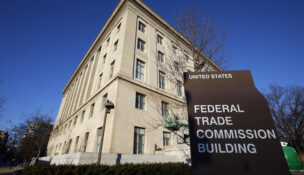2003 spawns 3 bad faith decisions
By: dmc-admin//May 26, 2004//
|
“When a case comes to you with bad facts where you know there has been a mistake, bite the bullet early, pay the damages and get out.” Ann Lampiris |
Several appellate decisions last year regarding bad faith claims have left the water a little murky regarding the appropriate ratio between compensatory and punitive damages, according to a Milwaukee mediator.
The veteran trial attorney says one thing is clear, if you catch on early that there is a problem with your client’s case, resolve the situation before it gets out of hand.
Ann Lampiris, who now conducts mediation and arbitration, has worked both sides of the civil litigation fence — plaintiff and insurance defense. Looking at three bad faith decisions, which came down from the U.S. Supreme Court, Wisconsin Supreme Court and Seventh Circuit Court of Appeals in 2003, Lampiris said there is an old adage that remains true.
“There’s a statement that you need to keep in mind as we go through these [cases]. ‘Bad facts make bad law,’” Lampiris told a group of lawyers attending the Civil Trial Counsel of Wisconsin Spring Conference. “Some of these cases, I’m not sure how they got to the point that they did, but they are there and we have to deal with them.”
Lampiris referred to decisions in three cases: State Farm v. Campbell, et al., 123 S.Ct. 1513, 538 U.S. 408, 155 L.Ed.2d 585 (2003); Trinity v. Tower, 261 Wis. 2d 333, 661 N.W.2d 789 (2003); and Mathias v. Accor Economy Lodging, 347 F.3d 672, 62 Fed. R. Evid. Serv. 1199, (7th Cir 2003).
There were points in each case when the defendants could have tried to cut their losses, she observed.
Case Lasts 22 Years
The Campbell case arose from an automobile accident in 1981 and continued through the U.S. Supreme Court decision, issued in 2003, Lampiris explained.
According to the decision, the accident occurred when Curtis Campbell passed six vans on a two-lane highway. Todd Ospital approaching from the opposite direction swerved to miss Campbell’s vehicle and collided with another vehicle, resulting in Ospital’s death and permanent injury to the driver of the other vehicle.
The Supreme Court decision’s introduction summarized the situation:
“Although investigators and witnesses concluded that Curtis Campbell caused an accident in which one person was killed and another permanently disabled, his insurer, petitioner State Farm Mutual Automobile Insurance Company (State Farm), contested liability, declined to settle the ensuing claims for the $50,000 policy limit, ignored its own investigators’ advice, and took the case to trial, assuring Campbell and his wife that they had no liability for the accident, that State Farm would represent their interests, and that they did not need separate counsel. In fact, a Utah jury returned a judgment for over three times the policy limit, and State Farm refused to appeal.”
“That’s not how you want the preamble to your case to start out,” Lampiris observed.
The jury awarded $186,000 for the death and injury. Campbell told State Farm he wanted to appeal and State Farm said they were paying the $50,000 policy limits and they were done with the case.
Lampiris said State Farm told Campbell, “You may want to put a for sale sign on your house.”
Campbell appealed and lost. He eventually agreed to assign the bad faith claim over to the plaintiffs in the case under an agreement where they would receive 90 percent of the bad faith claim and Campbell would receive 10 percent. The trial court issued summary judgment against State Farm for bad faith.
A jury awarded $2.6 million in compensation and $145 million punitive. The trial court reduced those amounts to $1 million and $25 million. The Utah Supreme Court kept the $1 million compensation, but reinstated the $145 million punitive award.
The U.S. Supreme Court found State Farm’s conduct to be “reprehensible.” The Supreme Court observed, “The trial court found that State Farm’s employees altered the company’s records to make Campbell appear less culpable. State Farm disregarded the overwhelming likelihood of liability and the near-certain probability that, by taking the case to trial, a judgment in excess of the policy limits would be awarded. State Farm amplified the harm by at first assuring the Campbells their assets would be safe from any verdict and by later telling them, postjudgment, to put a for sale sign on their house.”
The Supreme Court determined that punishment was appropriate but the 1:145 ratio between the compensatory and punitive awards was too much. The court sent the case back to the trial court for a more appropriate punitive award.
Lampiris noted that the case could have been settled early on for $50,000.
“Keep this in mind as your clients come to you and wonder what they should do with a case that they think is a little smelly, but they are not sure what they should do with it,” she said.
Refusal to Reform Policy
The Trinity case arose when a parochial school sought to purchase an insurance policy that provided coverage for staff driving students in their own vehicles. The school requested “drive other car” coverage, but the agent failed to check the appropriate box on the insurance form.
When a teacher had an accident while driving some students, the school found out that the policy did not include the requested coverage. The agent asked Tower to reform the policy, but Tower declined. In a memo, the vice president of op
erations expressed concerns about potential exposure.
“That’s a very dangerous area to get into,” Lampiris noted. “You do not want to be making these kinds of reformation and coverage decisions based on your potential exposure.”
Tower made a motion for summary judgment to be dismissed as a party in the claim. In that request, Tower neglected to tell the trial court that the agent had asked that the policy be reformed and the judge was displeased with Tower’s mischaracterization of the situation.
“If you correct a problem early on, you will be ahead and in much better shape than if you try to somehow get around it and misrepresent it. And for heaven’s sake don’t tick off the trial court,” Lampiris said.
Eventually, Tower did reform the policy and paid $409,000 for the injuries. However, Trinity pursued a bad faith claim. In a summary judgment, the trial court found bad faith as a matter of law. The jury awarded $3.5 million. The Wisconsin Court of Appeals determined that it had no problem with that amount, but said that it was inappropriate for the trial court to have decided bad faith in a summary judgment.
The state Supreme Court indicated it did not have a problem with finding bad faith as a matter of law.
“They said you don’t have to show that it was intentional disregard,” Lampiris explained. “What you have to show is that there was knowledge of reckless disregard for the lack of a reasonable basis for denying the coverage.”
However, the court went on to say that bad faith could not be unintentional. That statement creates some confusion given that they said intentional disregard did not have to be shown, she observed.
Buggy Case
Finally, Lampiris looked at the Seventh Circuit Court of appeals decision in Mathias. Unlike the first two cases, Mathias was not an insurance case. It involved a bedbug problem in a 191-room Motel 6.
Although motel operators were aware of a bug problem, they chose a minimal response to the situation. In 1998, they declined a recommendation to spray every room for a total cost of $500. In 1999 the motel had only one room sprayed. The hotel manager indicated refunds were being given to guests who complained about being bitten by bugs.
In November 2000, the plaintiffs received the last remaining room in the motel. It was identified as infested and was labeled “Do not rent until treated.” Unaware of the problem, the Mathiases took the room, became upset at the bedbug situation and brought suit.
The defendants brought a motion in limine seeking to exclude evidence related to bugs in other rooms, which the trial court denied. The court was irritated by the motion.
Lampiris observed, “They were mad. They said, ‘What do you mean? Of course, we’re going to take it into consideration. That is a frivolous motion.’”
The Mathiases were awarded $5,000 in compensation and $186,000 in punitive damages, which added up to $191,000. Given that the motel had 191 rooms, that was $1,000 for each room.
That resulted in a 1:37 ratio between compensatory and punitive awards. The court of appeals said it didn’t care for that ratio, but found that it was acceptable.
The Seventh Circuit decision stated, “All things considered, we cannot say that the award of punitive damages was excessive, albeit the precise number chosen by the jury was arbitrary. … But as there are no punitive-damages guidelines, corresponding to the federal and state sentencing guidelines, it is inevitable that the specific amount of punitive damages awards whether by a judge or by a jury will be arbitrary.”
To avoid the types of problems that arose for the defendants in each of those three cases, Lampiris offered this advice, “When a case comes to you with bad facts where you know there has been a mistake, bite the bullet early, pay the damages and get out.”
Tony Anderson can be reached by email.
Legal News
- Chicago man sentenced to prison after being caught with ‘Trump Gun’
- FTC bans non-competes
- Gov. Evers seeks applicants for Dane County Circuit Court
- Milwaukee man charged in dismemberment death pleads not guilty
- Democratic-led states lead ban on the book ban
- UW Madison Professor: America’s child care crisis is holding back moms without college degrees
- History made in Trump New York trial opening statements
- Prosecutor won’t bring charges against Wisconsin lawmaker over fundraising scheme
- Republican Wisconsin Senate candidate says he doesn’t oppose elderly people voting
- Vice President Harris to reveal final rules mandating minimum standards for nursing home staffing
- Election workers fear threats to their safety as November nears
- Former law enforcement praise state’s response brief in Steven Avery case
WLJ People
- Power 30 Personal Injury Attorneys – Russell Nicolet
- Power 30 Personal Injury Attorneys – Benjamin Nicolet
- Power 30 Personal Injury Attorneys – Dustin T. Woehl
- Power 30 Personal Injury Attorneys – Katherine Metzger
- Power 30 Personal Injury Attorneys – Joseph Ryan
- Power 30 Personal Injury Attorneys – James M. Ryan
- Power 30 Personal Injury Attorneys – Dana Wachs
- Power 30 Personal Injury Attorneys – Mark L. Thomsen
- Power 30 Personal Injury Attorneys – Matthew Lein
- Power 30 Personal Injury Attorneys – Jeffrey A. Pitman
- Power 30 Personal Injury Attorneys – William Pemberton
- Power 30 Personal Injury Attorneys – Howard S. Sicula











